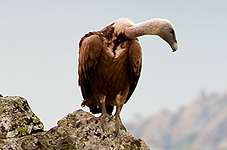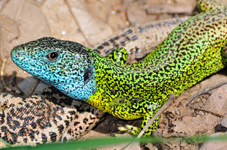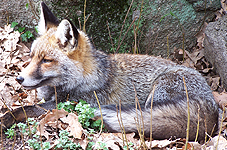Fauna
 |
 |
 |
|
Griffon Vulture. |
Verdinegros. |
Fox(Vulpes Vulpes). |
Fauna of MIRAFLORES de LA SIERRA
The different natural and humanized environments of Miraflores de la Sierra and the difference in altitudes and orientations favor the extraordinary diversity of its fauna.
Many mammals are nocturnal and go unnoticed, but it is easy to see the ibex in the higher areas. Between pine forests and oak groves discover the traces of roe deer,wild
boar and foxes, his vision will be just a fleeting flight that makes more interesting the silent walk through the woods. Other mammals pass even more unnoticed,such as
the weasel, marten, gineta, dormice and other rodents, except the squirrel, which can be seen in broad daylight. The most diverse are bats, especially forest species, and
those that take advantage of rural and urban constructions to take refuge. The wolf, as desired by naturalists as feared by cattlemen,
is at the gates of the municipality.
Birds are the most striking group. There are species that breed here and are found throughout the year, which in winter migrate to the south but choose the sierra to nest
and also some that come from the far north and pass in the low areas the hardest of winter. Finally, many migratory species pass through the Miraflores valleys.
Among the most outstanding species are the vultures, black and tawny, great eagles, royal, imperial, short-toed and Bonelli, as well as hawk, sparrowhawk, buzzard,
booted eagle, peregrine falcon and kestrels. With the night come the songs of the eagle owl, tawny owl, and even close to homes owls and owls. The mosaic mountain,
pine forest, oak forest, meadows and small crops, holm oaks and ash diversifies the presence of small birds, being very abundant robins,
Páridos in general, finches, warblers, washerwomen, mosquito nets, crossbills, thrushes, woodpeckers, etc. The cuckoo is revealed with its insistent song and, more rarely,
the críalo, which parasitizes the corvids. Among these, we will see the colorful and noisy jay and the gregarious and bluish blue-necked.
There is a great altitudinal variation in the species of reptiles: folder lizard at the top, green-black lizard near the water courses and the great ocelad in sunnier areas;
Guadarrama lizards and geckos in the most humanized and low areas. There are seven species of snakes, including the snout viper. Among the amphibians, the most
remarkable are the Iberian frog or legged and the salamander, endangered by the diseases that affect them.
The greatest fauna biodiversity is provided by invertebrates and especially insects. Many are endemic to the Sierra de Guadarrama, some in danger of extinction.
In the highest part, the Apollo butterfly flies and in the pine forests the Elizabethan. Others, no less striking, are macaón ypodalirio. Some have striking colors when
they open their wings but when closed they camouflage perfectly in the rocks, trunks, mosses and lichens.
Among the beetles are those associated with the oak, such as the large flying deer (Lucanuscervus) and the longicorn (Cerambix cerdo). But the most interesting
are the endemic species, highlighting the pipe beetles (Iberodorcadion), named for its resemblance to sunflower seeds. There are also highland endemisms among
grasshoppers and mountain cicadas.
Everyone, from the mountain goats to the smallest insects, are part of very complex ecosystems that must be studied and conserved.
Jesus Dorda Dorda
Conservator of the National Museum of Natural Sciences.





